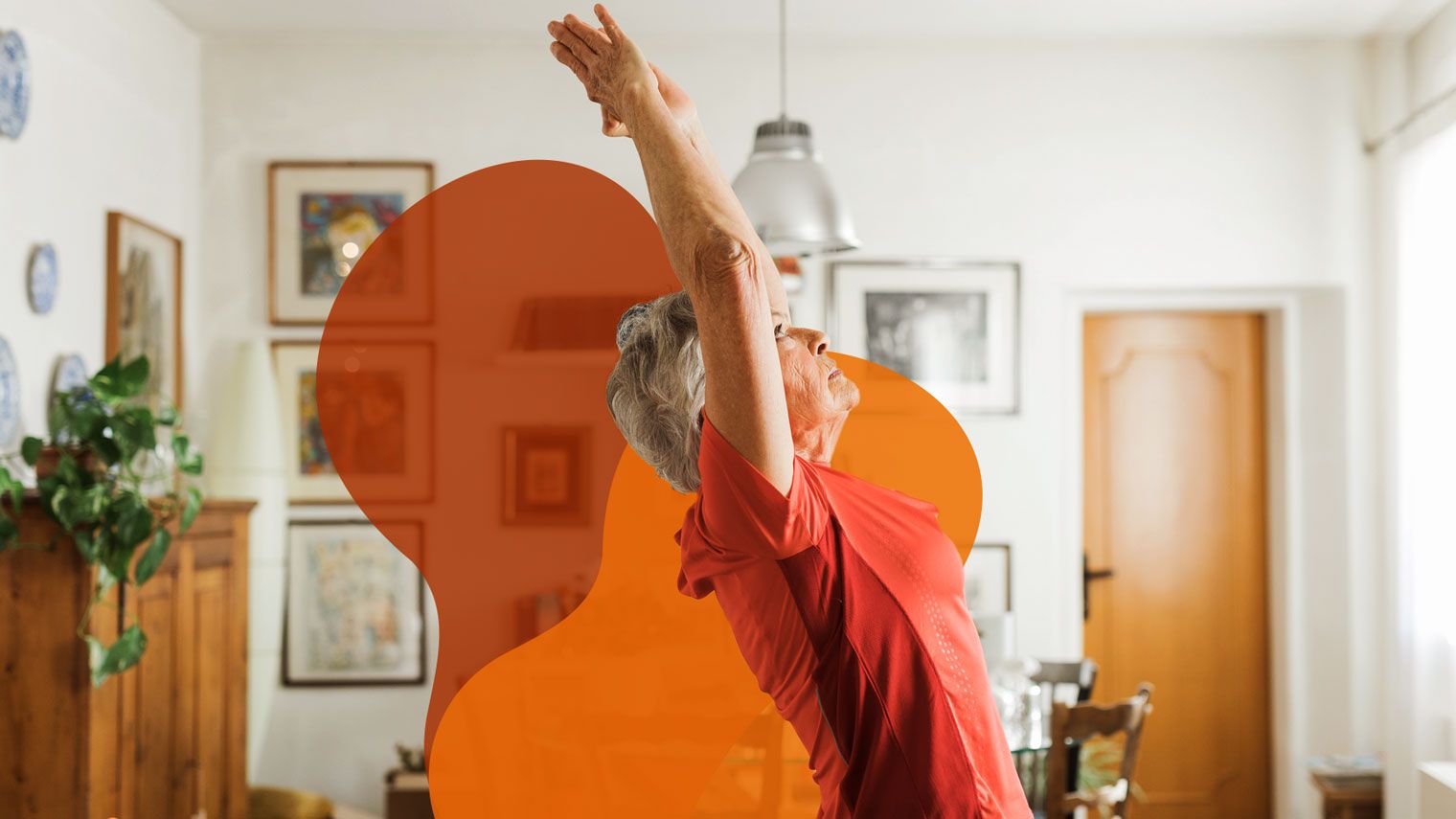Yoga for COPD: What to Know
Updated March 01, 2024
Content created for the Bezzy community and sponsored by our partners. Learn More

Photography by Studio Serra/Stocksy United
With the focus on controlled movement and breathing control, yoga can be a good option for those living with COPD, but it’s important to find the right fit for your needs.
Exercise is an important part of overall health and COPD management.
Moderate exercise can improve your energy, support your mental health, and help you maintain your strength and breathing. But finding the right exercise for you may take some trial and error.
Yoga can be a good option for many people living with COPD. It’s low impact with a focus on controlled breathing. Regular practice can help improve your emotional and physical health.
Benefits from the practice of yoga can include:
- lowered blood pressure
- increased relaxation and self-confidence
- reduced stress and anxiety
- improved fitness


What are the benefits of yoga for people with COPD?
Yoga classes created for people living with COPD offer a modified form of yoga, so don’t worry that you’ll be pushed to do more than you feel comfortable doing.
Instructors create these classes with the health needs of people with COPD in mind. Classes should provide a gentle, easy, and effective way to manage your health and emotional well-being.
Gentle stretching and bending exercises help improve fitness and flexibility, while breathing exercises give you the tools to manage your breath control. The techniques you learn should also be approachable enough so you can practice at home.
If you can’t find a class specifically designed for people living with COPD you can speak with a knowledgeable instructor about suitable options that may be available.
Some benefits yoga can offer include:
Modified movements
You can do yoga exercises standing or sitting, and they don’t require a lot of moving around. Asanas encourage flexibility while also building physical strength, which helps increase your exercise tolerance.
Enhanced breathing techniques
Pranayama breathing techniques can help you manage symptoms of breathlessness by strengthening your respiratory muscles.
Relaxation techniques
Yoga encourages deep relaxation through breathing and meditation techniques. This may help relieve stress and tension.
Social interaction
A yoga class for people living with COPD provides a fun, sociable activity. It gives you the opportunity to connect with others living with COPD.
Plus, spending time with other people on a regular basis can help improve your overall mood and reduce feelings of isolation.
What is yoga?
The National Center for Complementary and Integrative Health describes yoga as a “meditative movement practice.” This is because participants focus on not only their physical postures and breathing but also their thoughts and feelings.
Although its roots lie in Eastern philosophy, you don’t need any spiritual or religious beliefs to take part in a yoga class.
Not all yoga is the same. Different types may be a better fit for different skill sets. Some yoga classes may be customized for people with diagnosed health conditions, like COPD. The main thing is to find a form of yoga that works for you.
Most classes in the United States don’t focus heavily on the spiritual elements of yoga practice. But if you feel you would benefit from the spiritual side of yoga, you can look for a class that does.
There are deep meanings within the philosophy of yoga. For the purposes of this article, we focus primarily on two of the eight limbs of yoga: the physical postures, known as asanas, and breathing techniques, known as pranayamas.
What are asanas for people living with COPD?
Performing the physical postures of yoga, or asanas, can help improve your body’s general level of physical fitness, including:
- range of motion
- balance
- flexibility
- strength
Performing these postures can help raise your energy levels and clear your mind.
Always consult your doctor to get clearance before practicing any form of exercise. Also check that your yoga teacher is fully qualified and understands your needs as a person with COPD.
A good yoga teacher will show you how to breathe correctly to enhance your yoga practice.
The following yoga postures can help you build strength and maintain flexibility with COPD:
Standing Mountain Pose
This pose is straightforward: You stand up tall to open your chest. You can raise your arms or leave them at your sides.
Standing backbend
This pose also helps open the muscles of your chest. However, it needs to be practiced carefully to avoid muscle strain and breathlessness.
Seated forward bends
These poses help strengthen your respiratory system.
Standing side bends
These bends help strengthen your diaphragm while improving the flexibility of your rib cage.
There are many more asanas that can be modified to help you build strength and flexibility, specifically to help your COPD. It’s vital that you learn yoga from a qualified, licensed practitioner to get the most benefits.
What are pranyamas for people living with COPD?
Breathing techniques, or pranayamas, help you control your breathing and teach you how to use your lungs more fully, which are important practices for people with COPD.
You perform breathing exercises as you hold an asana and separately as a stand-alone breathing practice.
Yogis believe that correct breathing brings more oxygen into your blood and helps control vital energy, which in turn helps calm your mind.
Pursed-lip breathing and diaphragmatic breathing are two techniques that have roots in yoga. They’re often taught to people with COPD as part of a pulmonary rehabilitation program.
Another useful breathing technique for people with COPD is abdominal breathing. The technique is as follows:
- Breathe in, letting your stomach expand.
- As you breathe out, contract your stomach muscles, pressing your stomach inward.
- Focus on contracting your lower abdomen and ribs as you breathe out. This helps raise your diaphragm, enabling your lungs to empty all the way and thus improving the depth of your breathing.
Is yoga safe for those living with COPD?
Yoga is generally safe, but it’s always a good idea to take certain precautions when starting any exercise program:
- Speak with your doctor about trying yoga. You can also ask if they know of yoga classes for people living with COPD in your area.
- Check the credentials of any yoga teacher before you begin classes. Be sure to inform them of your condition and health needs.
- Avoid yoga poses that restrict breathing by putting pressure on the diaphragm, such as Child’s Pose or Plow Pose. Consult a yoga expert for advice on which asanas are suitable for people living with COPD.
- Keep your inhalers or oxygen supply close by when practicing yoga or any form of exercise.
- Stop exercising immediately if you experience shortness of breath while practicing yoga. Use your medication and rest until you feel well enough to begin again.
Has there been research about yoga for those living with COPD?
A 2019 review of studies notes that yoga could benefit both exercise capacity and pulmonary function in people with COPD. Review authors suggest that while yoga may be a good option for exercises, especially the breathing exercises, more research should be done to establish its safety.
Q: What are other types of exercise people with COPD should do?
A:
“Those with COPD can typically engage without limitations in regular stretching, walking, steady-state elliptical workouts, upper body strength training, and stairclimbing. Depending on the severity of COPD and fitness level, they may also be able to incorporate other exercises, such as jogging, biking, and non-contact sports. Always consult with your doctor before beginning any new exercises.”
Answers represent the opinions of our medical experts. All content is strictly informational and should not be considered medical advice.
Originally written August 03, 2017
Medically reviewed on March 01, 2024
2 Sources


Like the story? React, bookmark, or share below:
Have thoughts or suggestions about this article? Email us at article-feedback@bezzy.com.